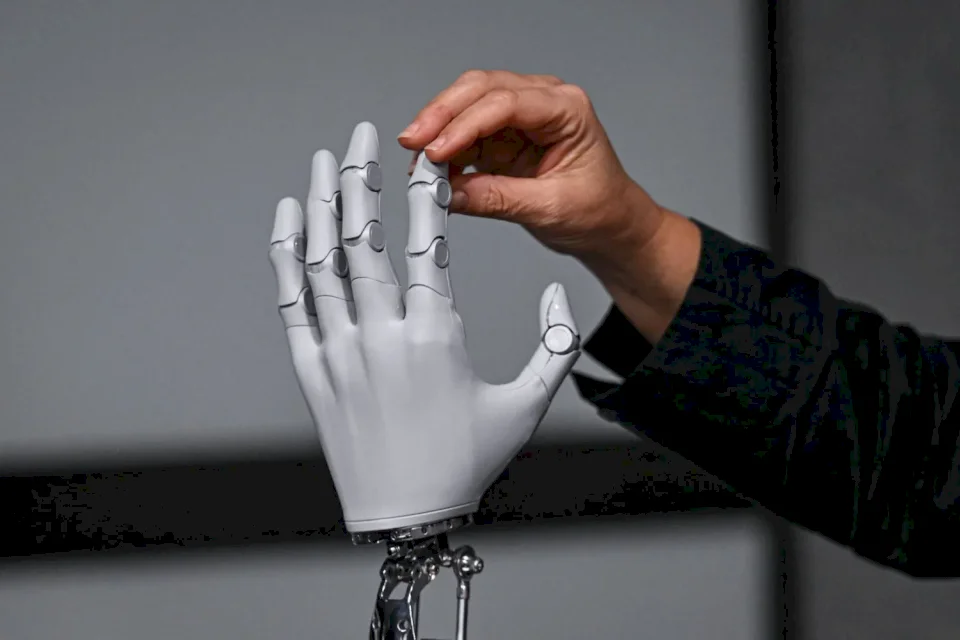
Smart Robots Learning to Work Like Humans... The Future of Physical Artificial Intelligence Begins in Japan
SadaNews - Two human-like arms developed for physical artificial intelligence research mimic the movements of a person wearing a virtual reality headset, as part of the effort to develop robots capable of performing human tasks.
The arms were designed by "Inactic," a Tokyo-based company, which is working on creating human-like robots capable of washing dishes and clothes in Japanese nursing homes suffering from a shortage of staff. The company asserts that with adequate training, robots like these can accomplish daily tasks independently without direct supervision.
These innovations are expected to shape the future of artificial intelligence, which is beginning to infiltrate the physical world in the form of smart robots, self-driving cars, and other autonomous machines.
Last year, Jensen Huang, the CEO of American chipmaker NVIDIA, addressed this issue, stating that "the next wave of artificial intelligence is physical AI." He explained that this is "AI that understands the laws of physics... capable of working among us."
In this context, companies are investing massive amounts in physical AI. Morgan Stanley predicted that the number of human-like robots could exceed one billion by 2050.
Recently, videos of robots performing dance movements or dragging heavy objects with ease have been increasingly shared.
Hiro Yamamoto, 24, CEO of Inactic, which uses NVIDIA and major universities' equipment for training physical AI, intends to start rolling out new robots still in testing next summer.
He explains to the French Press Agency that the goal is "to live alongside people in highly chaotic environments, where the conditions are constantly changing," such as nursing homes.
He emphasizes the necessity of making the robots "safe" and having a soft exterior that does not cause any harm.
Human Tasks
Japan is not alone in this field; last week in Guangzhou, China, a humanoid robot with feminine features and a glowing oval-shaped face slowly walked in front of cameras and journalists.
This device was the latest humanoid robot revealed by the Chinese electric vehicle manufacturer, XPeng, which has also entered the realm of physical AI.
Previously, machines made by American companies, such as dog-like robots, dominated headlines for years. However, government support and strong local supply chains are helping competitors in China, such as Unitree Robotics and EngineAI, to excel in the race towards future technologies.
XPeng's president, Xiao Peng, stated, "I haven’t thought much about how many robots we’ll sell annually over the next ten years, but I believe it will be more than cars."
The company’s robots are capable of walking and dancing, but expanding their ability to handle objects is a more complex task.
Peng ruled out the possibility of these robots replacing workers in China’s factories anytime soon, especially considering the cost of a robotic hand, which must be regularly replaced for strenuous tasks, is equivalent to a Chinese worker's salary for years.
Company official Brian Gu expects these robots to be able to perform "almost any human role", from caregivers to chefs.
On-the-Job Training
Text-based AI applications, like ChatGPT, are trained on massive amounts of words, but physical models must also deal with vision and the spatial relationship between objects.
Yamamoto, president of Inatic, explains that fine-tuning AI models connecting "vision, language, and action" requires between 30 to 50 demonstrations for each action.
The company reached out to nursing homes in Japan, suggesting that its remotely operated robots could take on heavy tasks, allowing qualified staff more time to care for the elderly.
The American-Norwegian startup 1X is taking a similar approach with its human-like home assistant, NEO, which is set to be provided to American households starting next year.
This robot costs $20,000, but its performance is still inconsistent; a video circulated by U.S. media showed the robot struggling to close a dishwasher door even when operated remotely.
Physical Limits
In another embarrassing scene, a humanoid robot from Russia, claimed to be the first in the country, wobbled and then fell during its debut on stage earlier this week.
Sarah Adila Abad Guaman, an assistant professor of robotics at University College London, speaks about the "huge gap" between robot AI systems and their physical capabilities.
She adds, "Nature has shown us that adapting to the environment requires a suitable physique."
Nonetheless, substantial deals are being made in the field of physical AI. Japan's SoftBank has confirmed that this field is its "next destination," announcing its acquisition of ABB Robotics for $5.4 billion.
Amid the concerns raised by AI regarding the future of human workers, Abad emphasizes that the discrepancies remain significant.
She clarifies, "Our sense of touch is unmatched."

New Spyware Targets Samsung Devices via Zero-Day Vulnerability

"Google" launches a mandatory program to verify "Android" app developers outside its offic...

Smart Robots Learning to Work Like Humans... The Future of Physical Artificial Intelligenc...

Pomegranate and Blueberries... Which has Higher Antioxidants and Provides Stronger Heart P...

Tea or Matcha: Which is Better for Energy and Blood Sugar?

Lentils or Beans... Which Provides More Protein and Fiber?

For a Longer Life and Healthy Aging... 9 Supplements That Make a Difference

